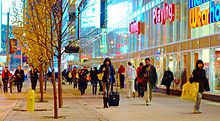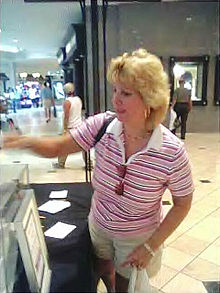|
Shopping
Shoppers at Yonge-Dundas Square in Toronto, Canada, in December 2009.
A retailer or shop is a business that presents a selection of goods or services and offers to sell them to customers for money or other goods. Shopping is an activity in
which a customer browses the available goods or services presented by one or more retailers with the intent to purchase a suitable selection of them. In some contexts it may be considered a leisure activity as well as an economic one.
A woman shopping at a shopping mall in the United States in December 2005
The shopping experience can range from delightful to terrible, based on a variety of factors including how the customer is treated, convenience, the type of goods being purchased, and mood.[1]

The shopping experience can also be influenced by other shoppers.
For example, research from a field experiment found that male and female shoppers who were accidentally touched from behind by other shoppers left a store earlier than people who had not been touched and evaluated brands more negatively, resulting in the Accidental Interpersonal Touch effect.[2]
According to a 2000 report, in the U.S. state of New York, women purchase 80% of all consumer goods and influence 80% of health-care decisions.[3]
History
Ancient era
In ancient Greece, the agora served as a marketplace where merchants kept stalls or shops to sell their goods. Ancient Rome utilized a similar marketplace known as the forum. For example, there was Trajan's Market with tabernae that served as retailing units.
Shopping lists
are known to have been used by Romans, as one was discovered near Hadrian's wall dated back to 75-125 CE written for a soldier.[4]
Fairs
and markets were established to facilitate the exchange of goods and services. People would shop for goods at a weekly market in nearby towns.
Consumer Shopping
Bernard Mandeville
's work Fable of the Bees, which justified conspicuous consumption.
The modern phenomenon of shopping is closely linked to the emergence of the consumer society in the 18th century. Over the course of the two centuries from 1600 onwards, the purchasing power of the average Englishman steadily rose. Sugar consumption doubled in the first half of the 18th century and the availability of a wide range of luxury goods, including tea, cotton and tobacco saw a sustained increase.[5]
Marketplaces dating back to the Middle Ages, expanded as shopping centres, such as the New Exchange, opened in 1609 by Robert Cecil in the Strand. Shops started to become important as places for Londoners to meet and socialise and became popular destinations alongside the theatre. RestorationLondon also saw the growth of luxury buildings as advertisements for social position with speculative architects like Nicholas Barbon and Lionel Cranfield.
Much pamphleteering of the time was devoted to justifying conspicuous consumption and private vice for luxury goods for the greater public good. This then scandalous line of thought caused great controversy with the publication of Bernard Mandeville's influential work Fable of the Bees in 1714, in which he argued that a country's prosperity ultimately lay in the self-interest of the consumer.[6]
Josiah Wedgewood
's pottery, a status symbol of consumerism in the late 18th century.
These trends were vastly accelerated in the 18th century, as rising prosperity and social mobility increased the number of people with disposable income for consumption. Important shifts included the marketing of goods for individuals as opposed to items for the household, and the new status of goods as status symbols, related to changes in fashion and desired for aesthetic appeal, as opposed to just their utility. The pottery inventor and entrepreneur, Josiah Wedgewood, pioneered the use of marketing techniques to influence and manipulate the direction of the prevailing tastes.[7]
As the century wore on a tremendous variety of goods and manufactures were steadily made available for the urban middle and upper classes. This growth in consumption led to the rise of 'shopping' - a proliferation of retail shops selling particular goods and the acceptance of shopping as a cultural activity in its own right. Specific streets and districts became devoted to retail, including the Strand and Picadilly in London.[5]
The first display windows in shops were installed in the late 18th century in London. Retailer Francis Place was one of the first to experiment with this new retailing method at his tailoring establishment in Charing Cross, where he fitted the shop-front with large plateglass windows. Although this was condemned by many, he defended his practice in his memoirs, claiming that he:
sold from the window more goods...than paid journeymen's wages and the expenses of housekeeping.[8]
Retailers designed attractive shop fronts to entice patronage, using bright lights, advertisements and attractively arranged goods. The goods on offer were in a constant state of change, due to the frenetic change in fashions. A foreign visitor thought that London was "A world of gold and silver plate, then pearls and gems shedding their dazzling lustre, home manufactures of the most exquisite taste, an ocean of rings, watches, chains, bracelets, perfumes, ready-dresses, ribbons, lace, bonnets, and fruits from all the zones of the habitable world".[5]
Department Stores
Le Bon Marché
, founded in Paris, offered a wide variety of goods in "departments" inside one building, from 1851.
The next stage in shopping was the transition from 'single-function' shops selling one type of good, to the department store where a large variety of foods were sold, ordered by department. As economic growth, fuelled by the Industrial Revolution at the turn of the 19th-century, steadily expande, the affluent bourgeois middle-class grew in size and wealth. This urbanized social group was the catalyst for the emergence of the retail revolution of the period. The first reliably dated department store to be established, was Harding, Howell & Co, which opened in 1796 on Pall Mall, London.[9]
This venture was described as being a public retail establishment offering a wide range of consumer goods in different departments. This pioneering shop was closed down in 1820 when the business partnership was dissolved. Department stores were established on a large scale from the 1840s and 50s, in France, the United Kingdom and the United States.
Online Shopping
Online shopping
or e-shopping is a form of electronic commerce which allows consumers to directly buy goods or services from a seller over the Internet using a web browser. Alternative names are: e-web-store, e-shop, e-store, Internet shop, web-shop, web-store, online store, online storefront and virtual store. Mobile commerce (or m-commerce) describes purchasing from an online retailer's mobile optimized online site or app.
An online shop evokes the physical analogy of buying products or services at a bricks-and-mortarretailer or shopping center; the process is called business-to-consumer (B2C) online shopping. In the case where a business buys from another business, the process is called business-to-business (B2B) online shopping.
The largest of these online retailing corporations are Alibaba, Amazon.com and eBay.[1] Retail success is no longer all about physical stores. This is evident because of the increase in retailers now offering online store interfaces for consumers. With the growth of online shopping, comes a wealth of new market footprint coverage opportunities for stores that can appropriately cater to offshore market demands and service requirements
Source:
http://en.wikipedia.org/wiki/Shopping
|